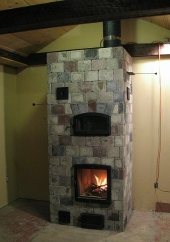thomas rubino wrote:Hi Hugh;
Any air gaps are insulators, you want to tightly fill all gaps.
Sand is not a good choice unless it is super fine, pebbles are not a good option either.
By filling any gaps you create a solid heat-holding mass.
Backing up Tomas on the sand, I had a 10 foot run that was pretty smooth, and wanted to pull some heat out, and before I knew how things would work, used about 1 foot of SAND by 2' wide, around the 10' long channel, perhaps 1-2" would get really warm, the next 3-4" just warm, and beyond that hardly a thing. Some cinder blocks were also involved, they did not do much as well. ( by much, I mean-adsorb heat) Pretty upsetting to carry in and then carry it all back out. But well learned was the task.
This brings up a question, I don't intend to do, but can see others that might try. I have a single large brick bell, 74 sq foot internal surface, so am at the desired goal of MASS when all said and done. But if I was to exit this bell with say a 8" round duct, ( it is a 7" system) and run this for 10 foot, before going into a 7" chimney, Is this a "fault" or something that should not be done, or does this not have much bearing if all the stove, and bell is done right. ???








